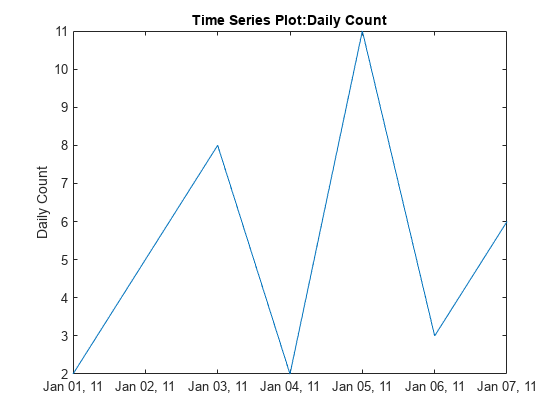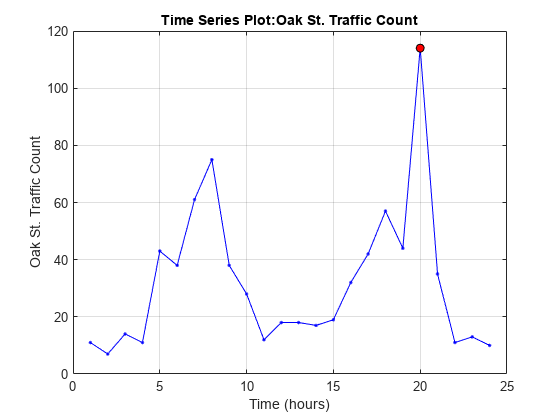plot
Representar gráficamente timeseries
Descripción
plot( representa gráficamente los datos de ts)timeseries en ts con respecto al tiempo, interpolando valores entre muestras.
plot( representa gráficamente los datos de ts,LineSpec)timeseries utilizando una gráfica de líneas y aplica los specs especificados a líneas, marcadores o a ambos.
También puede especificar argumentos de par nombre-valor para definir Line Properties.
p = plot(___) devuelve un objeto de Line o un arreglo de objetos de Line. Use p para modificar las propiedades de la gráfica después de crearla. Para obtener una lista de las propiedades, consulte Line Properties.
Ejemplos
Argumentos de entrada
Sugerencias
La función
plotgenera títulos y etiquetas de ejes automáticamente. Estas etiquetas son:Título de la gráfica:
'Time Series Plot: <name>'donde
<name>es la cadena asignada ats.Name, o por defecto,'unnamed'Etiqueta del eje X:
'Time (<units>)'donde
<units>es el valor del campots.TimeInfo.Units, cuyo valor predeterminado es'seconds'Etiqueta del eje Y:
'<name>'donde
<name>es la cadena asignada ats.Name, o por defecto,'unnamed'
Puede colocar nuevos datos de series temporales en una gráfica de series temporales (estableciendo
hold on, por ejemplo, y emitiendo un nuevo comandotimeseries/plot). Cuando se añaden datos a una gráfica, el título y las etiquetas de los ejes se convierten en cadenas en blanco para evitar confusiones en el etiquetado. Puede añadir sus propias etiquetas después de representar utilizando los comandostitle,xlabeleylabel.Los eventos de series temporales, cuando están definidos, se marcan en la gráfica con un marcador circular con relleno rojo. También puede especificar marcadores para todos los puntos de datos utilizando una función
linespeco sintaxis de nombre-valor, además de cualquier marcador de evento que definan sus datos. Los marcadores de eventos se representan encima de los marcadores que define.El valor asignado a
ts.DataInfo.Interpolation.Namecontrola el tipo de interpolación que utiliza el métodoplotcuando se representan y se vuelven a muestrear los datos de las series temporales. Invoque el métodosetinterpmethoddetimeseriespara cambiar la interpolación lineal predeterminada a interpolación de retención de orden cero (escalera). Este método crea un nuevo objetotimeseries, con el que se puede sobrescribir el original si se desea. Por ejemplo, para hacer que la serie temporaltsutilice la interpolación de retención de orden cero, escriba lo siguiente:ts = ts.setinterpmethod('zoh');
Historial de versiones
Introducido antes de R2006a































